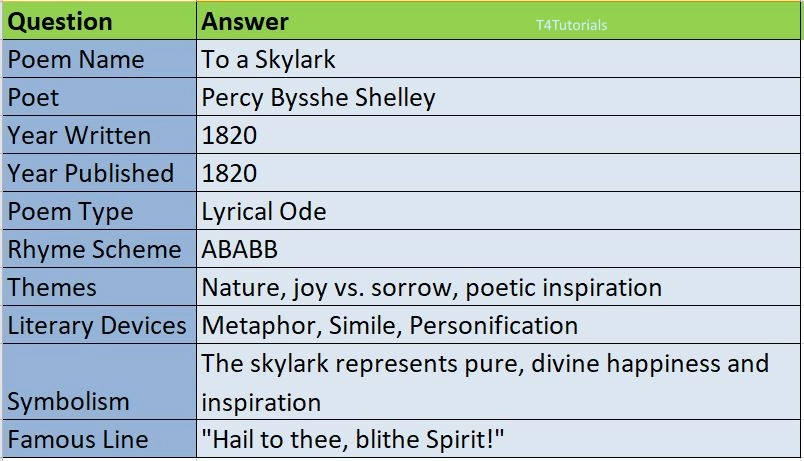Summary:
To a Skylark is one of Percy Bysshe Shelley’s most famous odes, written in 1820. The poem is an ecstatic celebration of the skylark, a bird that soars high in the sky, singing joyfully. Unlike humans, the skylark is free from sorrow and suffering, representing unbridled happiness and inspiration.
Shelley praises the bird’s song as more beautiful than any human music or poetry. He uses various metaphors, comparing the skylark to a star, a poet, a high-born maiden, and a golden glow in the sky. The poet expresses envy at the bird’s ability to sing without pain, unlike human poets whose greatest works often come from sadness.
In the final stanza, Shelley expresses a deep desire to learn from the skylark, hoping that if he could capture even a fraction of its joy, his poetry would have the power to move the world. The poem emphasizes the contrast between the skylark’s pure, instinctive happiness and human beings’ constant struggle with sorrow and imperfection.
MCQs:
- Who is the poet of To a Skylark?
a) John Keats
b) William Wordsworth
c) Percy Bysshe Shelley
d) Lord Byron
Answer: c) Percy Bysshe Shelley - When was To a Skylark written?
a) 1815
b) 1819
c) 1820
d) 1825
Answer: b) 1820 - What does the skylark symbolize in the poem?
a) Death
b) Freedom and inspiration
c) Suffering and sadness
d) Power and ambition
Answer: b) Freedom and inspiration - How is the skylark described in the poem?
a) As a bird trapped in a cage
b) As a spirit of joy and creativity
c) As a messenger of doom
d) As an ordinary creature of nature
Answer: b) As a spirit of joy and creativity - What poetic form does To a Skylark follow?
a) Sonnet
b) Blank verse
c) Lyrical ode
d) Epic poem
Answer: c) Lyrical ode - What is the main theme of To a Skylark?
a) War and heroism
b) The beauty and perfection of nature
c) The limitations of human life compared to nature’s beauty
d) Love and romance
Answer: c) The limitations of human life compared to nature’s beauty - What literary device is frequently used in the poem?
a) Metaphor
b) Simile
c) Personification
d) All of the above
Answer: d) All of the above - How does Shelley compare the skylark to a poet?
a) Both live in solitude
b) Both express emotions beautifully
c) Both are misunderstood
d) Both seek fame and glory
Answer: b) Both express emotions beautifully - What does the poet long for in the final stanza?
a) To become a skylark
b) To learn the skylark’s secret of happiness
c) To capture the skylark
d) To leave the earth and fly away
Answer: b) To learn the skylark’s secret of happiness - What is the famous closing line of the poem?
a) “Hail to thee, blithe Spirit!”
b) “Better than all measures of delightful sound”
c) “Teach me half the gladness that thy brain must know”
d) “Our sweetest songs are those that tell of saddest thought”
Answer: c) “Teach me half the gladness that thy brain must know”
| Question | Answer |
| Poem Name | To a Skylark |
| Poet | Percy Bysshe Shelley |
| Year Written | 1820 |
| Year Published | 1820 |
| Poem Type | Lyrical Ode |
| Rhyme Scheme | ABABB |
| Themes | Nature, joy vs. sorrow, poetic inspiration |
| Literary Devices | Metaphor, Simile, Personification |
| Symbolism | The skylark represents pure, divine happiness and inspiration |
| Famous Line | “Hail to thee, blithe Spirit!” |
